High Speed Flight Systems
|
|
Design, Build, Test, and Fly (DBTF) Time Reduction
Sponsor: Stratolaunch
Co-Investigator: Dr. Leifur Leifsson (AAE)
Synopsis: The team optimizes/minimizes the cycle time for the Design, Build, Test, and Fly (DBTF) process by using the SoS tools.
Advanced Hypersonics Technology
Sponsor: SAIC/Naval Surface Warfare Center
Synopsis: Indirect trajectory optimization can be a powerful tool in characterizing vehicle performance, design tradeoffs, and the impact of constraints in addition to specific mission planning. To enable this, this project has provided and refined a framework to quickly generate large families of high-quality optimal trajectories for hypersonic glide vehicles. Specific areas of investigation have included the relationship of control limits on reachability footprints and mission performance, the effect of variation in initial states and parameters, uncontrollability in certain regimes, and the tradeoff maximum range and terminal energy. Continued work strives to refine the vehicle model through more accurate dynamics, removal of simplifying assumptions, and better interpolation and improve indirect optimization tools and techniques for increased reliability and speed.
Additive Manufacturing and Digital Engineering Strategy Development
Sponsor: DoD
Synopsis: The research focuses on the data and framework surrounding the opportunity to exploit additive manufacturing as a systems engineering problem. First, we identify the critical decision and analysis variables and created a framework to understand how these variables impact each other. Second, we transfer the above framework into an algorithmic view of these variables to make an optimized decision regarding where and how additive manufacturing can have the most impact. Third, we develop an interactive decision support tool (i.e., the “decision Engine”) in additive manufacturing, supply chain, and digital engineering as part of the overarching goal of mission engineering. As we go through this research, we conduct three use cases to create the decision engine: aircraft fleet maintenance using additive management; spacecraft applications; and design, manufacturing, and maintenance of aircraft components. Finally, we create a roadmap for digital technical data packages to adopt additive manufacturing.
Hypersonics Advanced Manufacturing Technology Center (HAMTC)
Sponsor: The Office of the Secretary of Defense Manufacturing Technology (OSD ManTech)
Synopsis: The team uses the SoS and physics-based tools to confirm the effectiveness of the thermal protection system design for hypersonic vehicles.
Multidisciplinary Hypersonic Program: Enabling Technologies for High-Speed Operable Systems
Sponsor: Air Force Research Lab (AFRL)
Co-Investigator: Air Force Research Lab (AFRL)
Synopsis: The research includes developing and demonstrating a system-of-systems tool conglomerate to optimize complex design problems for hypersonic vehicles, which are subject to severe size, weight, and power sensitivities. In particular, we focus on the aerodynamics tool, trajectory simulation tool, ablation modeling tool, and optimization tool.
Data-Driven Capability Portfolio Management Pilot
Sponsor: DoD
Synopsis: The research adapts a previously developed system-of-systems analytic workbench prototype to create a decision-support prototype effective for informing decisions in Integrated Acquisition Portfolio Reviews. We demonstrate mission engineering analysis and portfolio optimization of an anti-surface warfare mission thread using personnel and munitions in the surface, aviation, and space domains. The advanced prototype provides a broader range of insights for stakeholder decision-making, such as resource tradeoffs, cost-sensitivity analysis, and the most robust anti-surface warfare systems to be acquired in specific portfolios.
Autonomy for Hypersonics
Principal-investigator: Dr. Ali K. Raz
Co-investigator: Dr. Daniel DeLaurentis
Sponsor: Sandia National Laboratories
Synopsis: The project is focused on the application of AI techniques for hypersonic vehicle mission planning. The objective is to investigate the use reinforcement learning (RL) for real-time guidance commands. We aim to define hypersonic mission modeling abstractions required to provide well suited means of exploratory analysis. The mission model is provided via DAF 2.0, in which abstract levels of agent capability are implemented to simulate a hypersonic flight environment. Optimal trajectories seed the RL agent for training and are used to compare against RL generated results. Trajectories generated by the autonomous hypersonic vehicle are validated, verified, and tested to quantify performance limitations of RL solutions.
Study of Swarm Characteristics and Modeling Innovations
Sponsor: Lockheed Martin Missiles & Fire Control
|
Advanced Aerial Mobility & Air Transportation Systems
|
|
Secure and Safe Assured Autonomy (S2A2)
Sponsor: NASA University Leadership Initiative
Synopsis: The recent introduction of unmanned systems into the NAS will bring challenges and opportunities for the nation’s aviation system. The integration of such a complex transportation system creates a clear need to develop new technologies and innovative operational concepts for secure and safe assured autonomy. An unmanned systems future will see the integration of a wide variety of Unmanned Aerial Systems (UAS), personal air vehicles, Urban Air Mobility (UAM) vehicles, and cargo and special mission aircraft into the NAS. These developments can leverage UAS Traffic Management (UTM) advancements for the unique requirements of UAM airspace management. The main challenges include: (i) sensing and understanding complex operational surroundings, coordinating different types of aerial vehicles, planning and navigation through highly dynamic and uncertain environments; (ii) securing the NAS against a wide range of malicious adversarial threats, specifically cyber-physical attacks; (iii) verifying and validating autonomous system operation; and, finally, (iv) properly integrating new vehicles and traffic management approaches in the midst of autonomy. Our primary goal is to ensure safe, secure and robust integration of autonomous vehicles into a UAM-tailored transportation infrastructure while maintaining compliance with existing commercial and civil air transportation safety standards.
Aircraft Technology Modeling and Assessment - NextGen Supersonic Fleet evaluation
Principal-investigator: Dr. William Crossley
Co-investigator: Dr. Daniel DeLaurentis
Sponsor: FAA ASCENT Center of Excellence
Synopsis: The project is focused on developing a model that measures fleet-wide environmental impact from new aircraft concepts and technologies under various carbon policy scenarios, based on an approach that mimics airline behavior. Fleet-level Environmental Evaluation Tool (FLEET) considers uses a "system dynamics-like" approach to allow demand, fleet size/composition, and fares to evolve over time while considering scenarios with varying technological, policy, & economic factors. The current focus is a collaborative effort between Georgia Institute of Technology and Purdue University to leverage capabilities and knowledge available from the multiple entities that make up the ASCENT university partners and advisory committee. Purdue's primary directive for this research project is to support the Federal Aviation Administration (FAA) in modeling and assessing the potential future evolution of the next-generation supersonic aircraft fleet. Purdue's research under this project consists of three integrated focus areas: (a) establishing fleet assumptions and performing demand assessment; (b) performing preliminary SST environmental impact prediction; (c) performing vehicle and fleet assessments of potential future supersonic aircraft. More details are available at the project website.
|
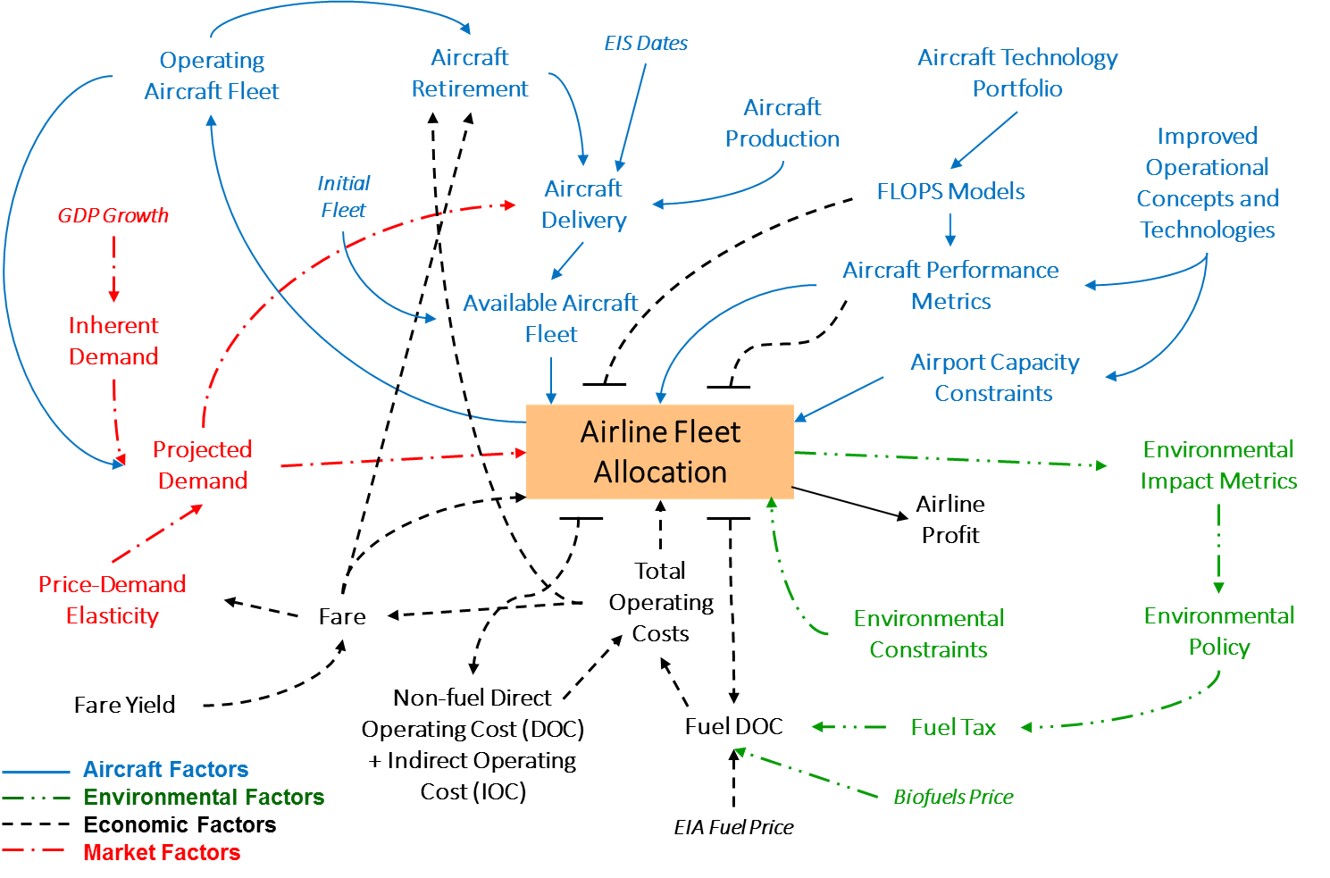 |
|
|
Traffic Information Exchange Netowrk (TIEN)
Sponsor: SAIC/Naval Surface Warfare Center
Synopsis: Traffic Information Exchange Network is a relay-based broadcasting protocol that can enable data sharing between multiple devices. The protocol works similarly to “gossip protocol” where a device keeps listening to the neighboring broadcasted messages and whenever it receives a message, it adds its own information on top of the old one and broadcasts the new message. This mechanism enables two distant devices to share information with each other through a device in between. This is especially important in an urban environment where information between two relatively closer drones can be blocked due to obstacles, such as skyscrapers. Relay mechanism ensures that the critical information is received if reasonable density of the devices in the area is maintained. Currently the focus is on the development and testing of a secured data relay system for UAVs. As part of this effort, the data-relay capability and performance of TIEN in a dynamic traffic environment, has been characterized using an in-house simulation environment. Additionally, our group successfully implemented the protocol on a prototype hardware and performed proof-of-concept experiments, on Purdue campus, to demonstrate the relay mechanism. This project intends to enhance TIEN capability and demonstrate its cybersecurity mechanism. There are three distinct tasks to validate the potential of TIEN: (i) investigating and enhancing the TIEN’s cyber-security capabilities, (ii) identification of path to integrate TIEN with other airspace management systems, and (iii) improving vehicle localization accuracy in urban environment using TIEN communication properties.
Enhanced methodology for exploring autonomy-enabled multi-mode regional transportation
Sponsor: Center for Connected and Automated Transportation
Synopsis: Increasing the level of autonomy in both small aircraft and automobile has the potential to generate greater efficiency and utility in multimodal regional transportation systems. In previous research, the PI and collaborators developed a computational analysis framework to assess the impact of aircraft technology advancement in electric propulsion and autonomy on the future of on-demand, regional air transportation system. A sensitivity analysis revealed increasing level of autonomy and an improved ride-sharing model (on the ground and in the air) could lead to significant increase in the total number of individuals who could afford this new mode of transportation. Activities in this project would enhance our current computational framework with models for autonomous automobile option and thereby take a holistic approach to evaluate the impact of autonomy at a multi-modal level of operation. The end results will help identify the promising regions, via an optimization formulation, where enabling autonomy makes economic sense to the stakeholders. Outcome models, analysis, and metrics is expected to further increase the research community’s ability to characterize the impacts of differing levels of autonomy as well as the synergistic benefit of a ride-sharing economy within the context of a multi-modal transportation system.
|
|
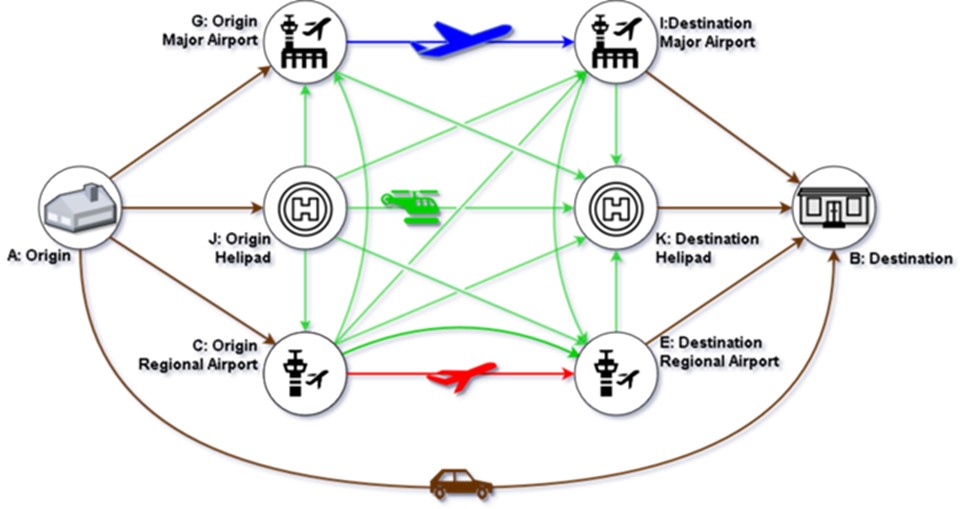
|
|
Data-driven monitoring framework for terminal airspace
Sponsor: Robust Analytics
Synopsis: The objective of the project is to develop predictive models and metrics for the terminal airspace to predict safety margins and operational states for the airspace. The ability to tightly integrate data-driven analytics into airspace operations is paramount for the transition from current legacy systems to flexible systems that can incorporate UAV traffic, future autonomous systems We leverage aviation data sources (e.g., Traffic Flow Management System (TFMS), Notice to Airmen (NOTAMs), weather data, etc.) to develop airspace safety models and supporting analytical tools for flight track prediction, anomaly identification (e.g., go arounds, holding patterns), and operational changes.
|
 |
|
Developing an Air Connectivity Index for the United States
Sponsor: Federal Aviation Administration
Synopsis: The Air Connectivity Index (ACI) is a measure of network connectivity developed by researchers at The World Bank to determine the importance of a node within the worldwide air transport system. The ACI may be used to measure the importance of air transportation in the overall global economy. The purpose of this project is to develop an ACI for the United States network and determine if air transportation infrastructure encourages economic growth and development.
|
|
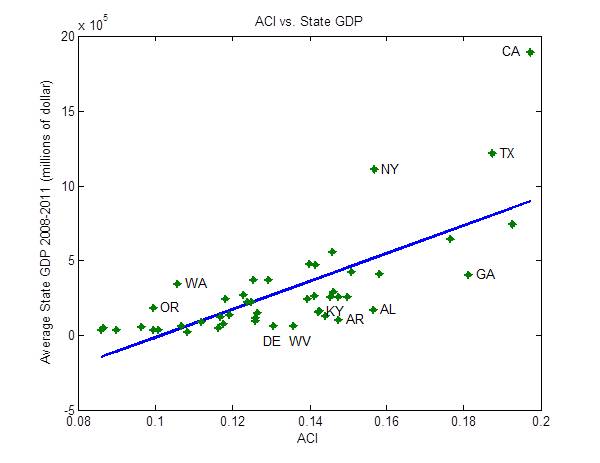
|
|
|
|
Modeling and Simulation for Unmanned Aircraft Systems in the National Airspace System
Co-investigators: Dr. Crossley (AAE), Dr. Hwang (AAE) & Dr. Wieland (Intelligent Automation Inc.)
Sponsor: NASA Langley Research Center
Synopsis: The objective of the project is to analyze twelve UAS vehicles to create Base of Aircraft Data (BADA) formatted aerodynamic data for each one, useful in simulation tools such as Airspace Concept Evaluation System (ACES) and Multi Aircraft Control System (MACS). Through industry partners and contacts with UAS manufacturers the team will identify potential operational limitations, communication, navigation and surveillance capabilities of the 12 vehicles that includes fixed wing UAVs, rotorcraft and hybrids. BADA files for these vehicles are developed with the help of NASA's Flight Optimization System (FLOPS) and other in-house, integrated aircraft sizing tools.
|
|
|
|
System-of-Systems Approach for Assessing New Technologies in the Next Generation Air Transportation System
Co-investigator with Dr. William Crossley, AAE
Sponsor: NASA Fundamental Aeronautics Program
Synopsis: The objective is to develop methods and tools that enable the exploration of potential long-range, fleet wide benefits from advanced technologies/vehicles in a variety of future scenarios. This project combines aircraft design, variable resource allocation, and network evolution research to project fleet benefits and emissions.
|
|
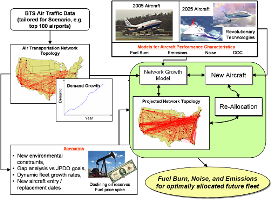
|
|
|
|
|
|
Network Restructuring Scenarios for ATO Forecasts
Sponsor: Federal Aviation Administration (FAA)
Synopsis: Through topological analysis of service networks and new algorithms for forecasting network dynamics, the objective is to identify the likelihood of new city pairs - new links - in the future air transportation system as well as the potential for new airline hubs to arise or old hubs to be eliminated.
|
|
A Systems Study of Safe, High-Capacity Architectures for Future Airspace Operations (Ab-Initio)
Principal Investigator: Dr. Steven Landry
Co-Investigators: Dr. Daniel DeLaurentis
Sponsor: NASA
Synopsis: The objective is to develop an Ab Initio architecture study for a future, safe, high-capacity air transportation system. Ab Initio architecture implies that no assumptions of current NAS, such as sectors, air space restrictions, etc., apply. This will help characterize the safety and capacity of future NAS via DAF simulation based on SySML representation. The approach for this project includes three steps: first, we develop the requirements for SySML DAF integration, second, we simulate the NAS and obtain performance metrics, and three, we compare the future NAS performance metrics with those of the current one. Agent-based modeling via DAF, discrete event simulation, and system modeling using SysML are all utilized in this project.
|
|
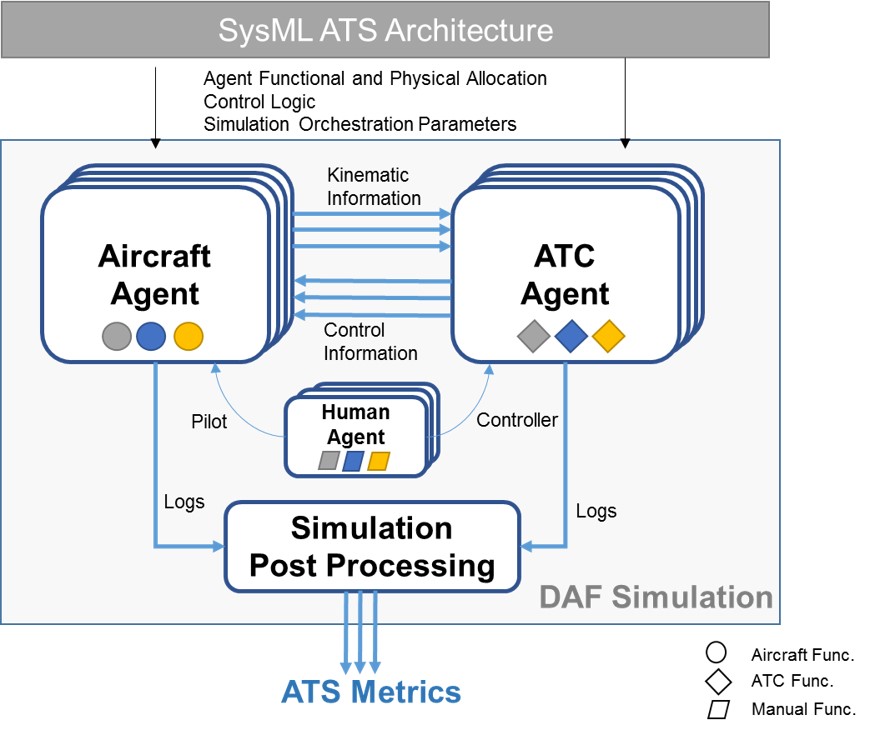
|
|
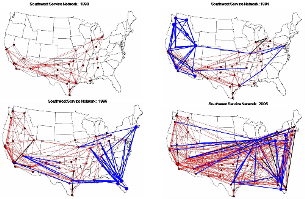
|
|
|
|
SoS Analysis of Metroplex Dependencies: Relationship between Policy, Economics, & Technology
Study Lead: George Mason University
Sponsor: NASA Airspace Systems Program
Synopsis: The objective is to develop and exercise a comprehensive framework for characterizing SoS dependencies in a Metroplex and develop methods to account for complexity in modeling and simulation and network effects on Metroplex development.
|
|
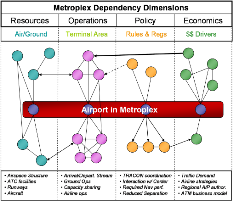
|
|
AURORA - AEQUOR-V (AErial aQUatic Ordinance Removal Vehicle)
Sponsor: Aurora Flight Sciences / Office of Naval Research (ONR)
Synopsis: The objective is to undertake a system-level design space exploration of hybrid aerial/underwater vehicle and determine the best vehicle architecture from a system performance perspective. Furthermore, the sensitivity of the selected vehicle design to high-level mission parameters (range, payload, number of targets, etc.) is analyzed. The focus of our research group is primarily on studying different propulsion systems and developing an appropriate propulsion model.
|
|
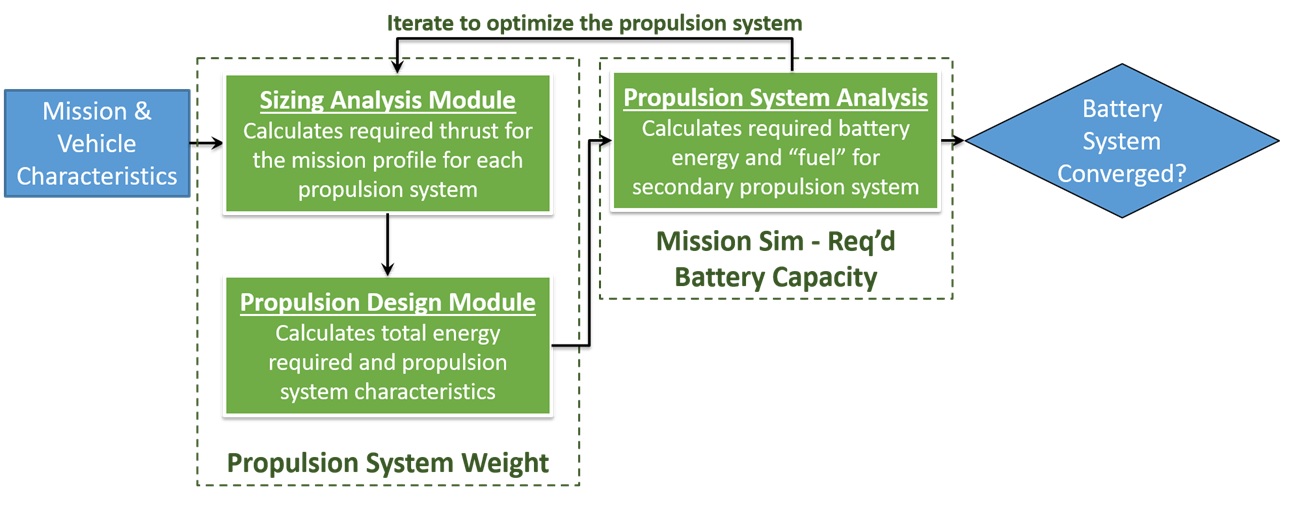
|
|
Safety Assessment for Separation Assurance in a Distributed Environment
Co-Investigators: Dr. Steven Landry
Sponsor: NASA
Synopsis: The objective is to analyze how faults in avionics can affect the safety in an airspace with self-separating aircraft. The key thrust of the project is to model and simulate faults in communication and surveillance devices in DAF airspace simulation framework and quantitatively assess their effects. The safety assessment is carried out by using a family of safety metrics.
|
|
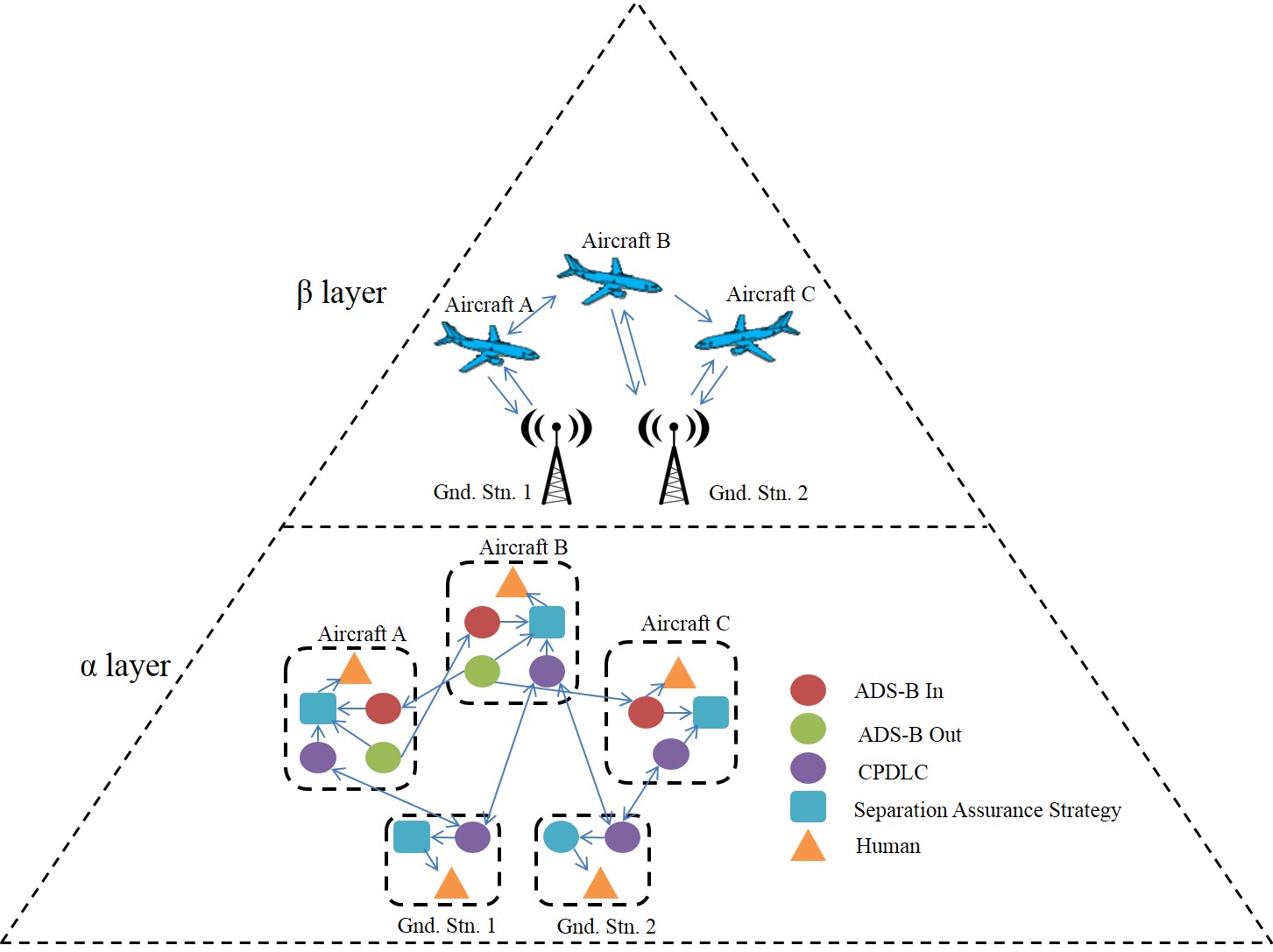
|
|
|
|
|
|
A Concept for Flexible Operations and Optimized Traffic into Metroplex Regions
Co-investigators: Dr. Landry (IE), Dr. Sun (AAE), and Dr. Wieland (Intelligent Automation Inc.)
Sponsor: NASA Langley Research Center
Synopsis: The objective is to determine whether this new concept of flight plan (Flexible operations and optimized traffic into Metroplex regions) has operational value in the future. This project combines FFS (Flexible Flight Selection Model), LTV (Linear Time Varying Optimization Model), McTMA (Multi-center Traffic Management Advisor Model), and ACES (Airspace Concepts Evaluation System). This concept should allow the NAS to maximize Metroplex airport throughput, increase its resiliency to disruptions, allow maximum flexibility for users, and degrade gracefully under adverse conditions.
|
|
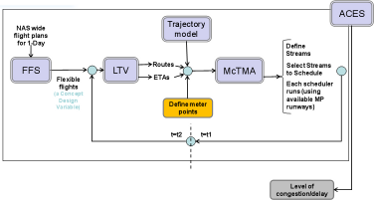
|
|
|
|
Shared-Autonomy in Automotive Swarm
Sponsor: Honda
Synopsis: The objective is to develop optimal architectures for shared-autonomy control for swarm of vehicles operating at high speeds in close proximity. The approach combines fuzzy-logic based control with Genetic Algorithm search techniques in a MATLAB derived simulation environment.
|
|

|
Space Systems
|
|
Mars Sample Return (MSR)
Sponsor: NASA Jet Propulsion Laboratory (JPL)
Synopsis: Developing State Machine Diagrams to model surface operations of the MSR mission, to execute Probabilistic Risk Assessment (PRA) of the mission.
|
|
Modeling Architectures and Parametrization for Spacecraft (MAPS)
Internal project
Synopsis: The Modeling Architectures and Parametrization for Spacecraft (MAPS) Environment was constructed in-house by students. The environment, coded in MATLAB, enables non-traditional analysis of spacecraft and space architectures. Multiple scenarios and architecture designs can be evaluated, and users can perform trade studies based on several metrics, including cost and complexity. Additional tools enable extensibility, repeatability, and decision support. The object-oriented nature of the environment allows the SoS group to continue developing the environment. Current work is underway to import information directly from SysML models into the environment.
|
|
Performance Measures for Autonomous Intelligent Agents in Satellite Systems (PEAS)
Principal-investigators: Dr. Jitesh Panchal (Purdue), Dr. Laura Freeman (Virginia Polytechnic Institute & State University)
Co-investigators: Dr. Daniel DeLaurentis
Sponsor: National Reconnaissance Office
Synopsis: As space assets become more intelligent, it is imperative that we are able to evaluate their performance accurately. The Performance Measures for Autonomous Intelligent Agents in Satellite Systems (PEAS) is a collaborative effort between Purdue University and Virginia Polytechnic Institute and State University to establish a framework to measure the performance of Autonomous Intelligent Agents (AIAs) in spacecraft for the National Reconnaissance office (NRO). In the past year, the team molded a constellation of Earth observing satellites and the intelligent agents that control them. Then, the team developed performance measures that include typical metrics used to assess spacecraft, such as mass and propellant consumption, in addition to measures that evaluate intelligent collaborative systems,such as degree of trust. Future efforts involve evaluating performance measures for complex teams of spacecraft.
|
|
Characterizing Mission and System Architecture via Analysis of Operational and Developmental Interdependencies
Sponsor: NASA Marshall Space Flight Center
Synopsis: The objective is to analyze and compare architectures for the human exploration of Mars based on analysis of the impact of interdependencies. The approach involves identifying items in human Mars exploration architectures and modeling and analyzing them using SODA, SDDA, and RPO.
|
|

|
|
Architecture Analysis for NASA's Constellation Program Lunar C3I Concepts
Co-Investigator: Prof. Barrett Caldwell, IE/AAE
Sponsor: NASA's Constellation Program Systems Engineering and Integration Office
Synopsis: The purpose of this project is to abstract and construct an architectural analysis model of the NASA's Constellation Program Lunar Command, Control, Communication and Information (C3I) architecture trade space investigation, and then to employ this model to demonstrate sensitivity analysis and trade space exploration across multiple metrics. The objective of this study is to demonstrate the ability to improve informed decision support in architecting of the Lunar C3I architecture and other space exploration related architectures via the application of the our three-phase Process Model for System-of-Systems Engineering.
|
|
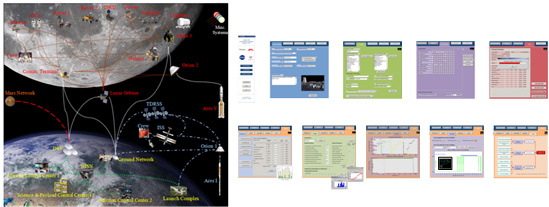
|
System of Systems/ Systems Engineering Methodologies
|
|
Mission Engineering-based Integrated Acquisition Portfolio Review (IAPR) Decision-Support Tool
Co-investigator: Dr. Jitesh Panchal (ME)
Sponsor: Department of Defense (DoD) via AIRC
Synopsis: The team adapts the SoS AWB to create decision-support prototype tools for the Integrated Acquisition Portfolio Reviews (IAPRs) and demonstrates the capability using an anti-surface warfare (ASuW) mission thread.
Mission-Aware Integrated Digital Transformation for Operational Advantage
Principal-investigator: Dr. Jitesh Panchal
Co-investigator: Dr. Daniel DeLaurentis
Sponsor: Department of Defense (DoD)
Synopsis: The project explores digitalization efforts within the Department of Defense (DoD), drawing insights from in-depth stakeholder interviews and a thorough review of existing guidelines, standards, and literature. It examines the Technical Data Package (TDP) based on MIL-STD-31000, assessing its limitations for sustainment. The project extensively explores digital models in ground vehicle development, focusing on the Joint Light Tactical Vehicle (JLTV) and detailing the types of data used alongside the application of the NATO Reference Mobility Model. Additionally, the project develops a metamodel for the JLTV TDP. The project proposes short-term enhancements for TDP and outlines long-term strategies to adapt to the rapidly evolving digital landscape. Emphasizing the adoption of digital technologies, optimizing data utilization, and addressing data challenges are central to enhancing the operational readiness and effectiveness of the DoD.
Pilot Program Design to Test Innovative Approaches in Negotiating Intellectual Property
Principal-investigator: Dr. Daniel DeLaurentis
Sponsor: Department of Defense (DoD)
Synopsis: Intellectual property (IP) rights are essential for operational, sustainable, adaptable, and cost-effective systems in the Department of Defense (DoD) acquisitions. The DoD needs proper IP and technical data rights to prevent issues like vendor lock, limited sourcing, and high sustainment costs. On the other hand, Defense Industrial Base (DIB) companies view their IP as a valuable asset. Therefore, differing perspectives on IP rights between the DoD (seeking access) and DIB entities (seeking protection) create tensions that must be managed carefully. Recent advancements in additive manufacturing (AM) add IP management challenges, necessitating careful contractual considerations. This project proposes a decision framework to address these AM IP challenges, covering scenario screening, AM lifecycle, IP asset identification, and strategy options. The research illustrates the framework through three vignettes: 1. limited access to original equipment manufacturers; 2. demand surge; and 3. maintenance, repair, and operations. Furthermore, the project identifies future research pathways to enhance sustainable defense acquisition practices.
|
|
Mission Aware Digital Transformation
Sponsor: NASA Jet Propulsion Laboratory (JPL)
Synopsis: The team identifies current best practices in digital modeling for DoD and develops actionable recommendations for cohesive operations-driven digital modeling.
STEM Workforce
Sponsor: DoD via SERC
Co-investigators: Dr. Bill Rouse (external, PI), Dr. Mike Gargano (external), Dr. John Lombardi (external), Dr. Joyce Main (ENE)
Synopsis: DoD is interested in the STEM pipeline from K-12 through college to STEM workforce. Our side is in charge of implementing a Systems Dynamics model of the flow of students through STEM in college, and of adding appropriate factors and policies that can modify this flow based on demographics. The rest of the team at Purdue performs meta-analysis to retrieve quantitative data to be added to the model.
|
|
Predictive and Prescriptive Methods for System-of-Systems Acquisition
Sponsor: Naval Postgraduate School
Synopsis: System-of-Systems capability emerges from the collaboration of multiple systems, which are acquired from independent organizations. The systems within an SoS serve two purposes: one is to meet their own independent objectives, and the second is to contribute some capability to the SoS from which all constituents can benefit. In recent decades, the fields of machine learning and data analytics have found widespread application in system design and acquisitions. It is unanimously understood that any organization acquiring a complex system employs some form of data analytics to assess a system’s independent objectives. Even Acquisition Research Program: Creating Synergy for Informed Change - 2 - though the systems contribute to and benefit from the larger SoS, the data analytics and decision-making about the independent system is rarely shared across the SoS stakeholders. The objective of this work is to identify how the sharing of datasets and the corresponding analytics among SoS stakeholders can lead to an improved SoS capability. We propose to utilize machine learning techniques to predict the SoS capability by sharing pertinent datasets and prescribe the information links between systems to enable this sharing.
|
|
Quantitative Dynamic Planning in Human-in-the-loop Multi Agent Systems
Principal-investigator: Dr. Shaoshuai Mou
Co-investigators: Dr. Daniel DeLaurentis (Purdue), Dr. Joydeep Biswas (UT Austin), Dr. Bing Liu (UIC)
Sponsor: Northrop Grumman (REALM)
Synopsis: Rescue teams descended on the destruction left by Hurricane Michael in October, frantically searching for survivors. But a week later, more than 1,000 people were still unaccounted for, leaving families to wait and hope. Drone assistance in natural disaster response now is simplistic at best with a number of hurdles. The main focus is to use artificial intelligence and learning algorithms to create a platform allowing multiple drones to communicate and adapt as mission factors change. In this research, AI and machine learning techniques will assist the system in many ways, such as in object recognition and human-machine communication, and improving the system performance over time. Especially the system assisted by AI will allow for input from a human commander into the mission parameters and lets the drones provide feedback and even suggestions in natural language. Distributed control, human-machine mixed autonomy, life-long learning and artificial intelligence will be the key enablers.
|
|
Learn 2 Gamebreak (L2G)
Co-investigators: Dr. Ali K. Raz (AAE), Dr. Jitesh Panchal (ME)
Sponsor: DARPA
Synopsis: The L2G project seeks to develop and apply Artificial Intelligence (AI) techniques to existing open-world video games to quantitatively assess game balance, identify parameters that significantly contribute to the game balance and explore new capabilities, tactics, and rule modifications that are most destabilizing to the game. For Gamebreaker, game balance is defined as an inherent property of the game that reflects the win/loss ratio of players of equal skill level based on strategies and tactics employed within the game. For example, in a balanced game, if the skill level of both players is equal, each player will win 50 percent of the total games played. Similarly, if the skill level of both players is equal, but one player wins disproportionately due to inherent advantages arising from a condition of the game construct, the game is unbalanced. The commercial gaming industry has a long-standing interest in maintaining game balance since balanced games are more entertaining, and market pressures drive their development. Contrary to these market goals, strategists in the military deliberately explore technologies that maximize imbalance to increase the probability of their winning.
|
|
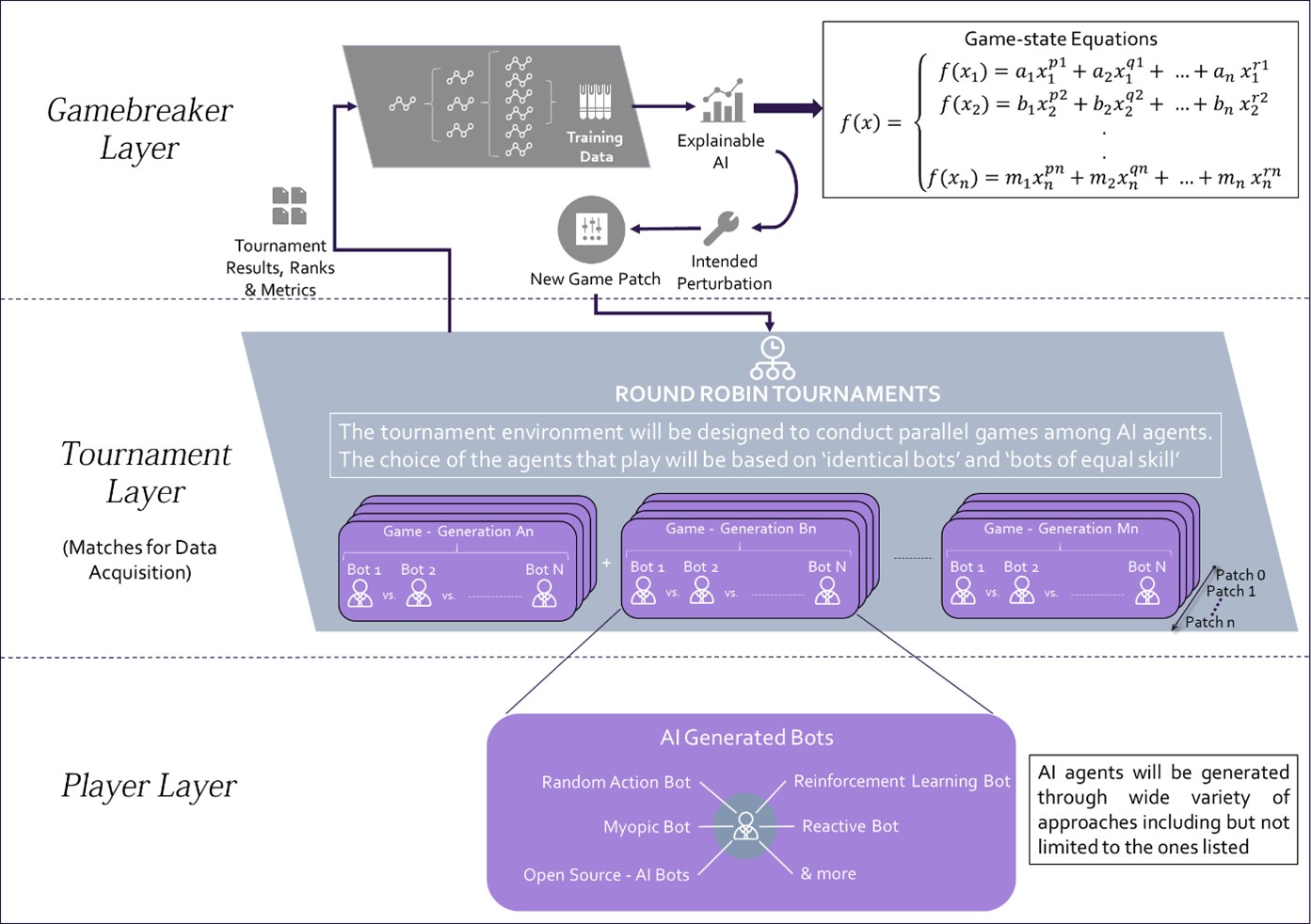
|
|
Development of Model-Based Engineering (MBE) processes
Sponsor: Charles Stark Draper Laboratories, Inc. / NSWC Crane
Synopsis: The objective is to generate repeatable process for block upgrades among a distributed set of players towards integrated M&S for model-based testing and V&V. We use machine learning and optimization based approaches to implement reverse engineering phase of 'Diamond Model' process.
|
|
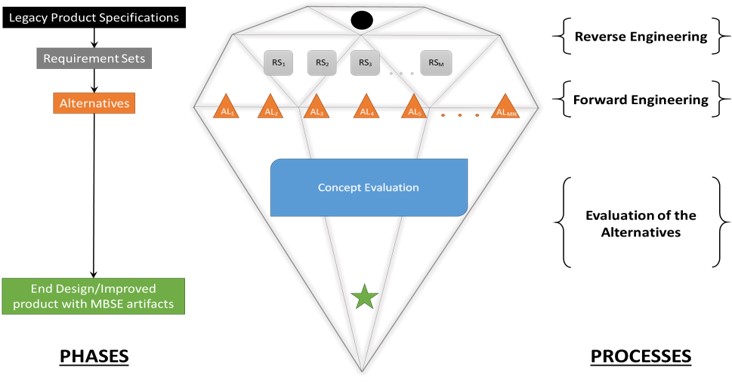
|
|
Optimal Selection of Organizational Structuring for Complex System Development and Acquisition
Sponsor: Naval Postgraduate School (NPS)
Synopsis: The objective of this work is to formulate and demonstrate an approach that seeks to reduce the inefficiencies attributed to the mismatch between a product architecture and the structure of the organization that developed it. The research leverages perspectives from organizational psychology and operations research to enable the objective selection of a modular product architecture, and, organizational structure. We demonstrate the approach for a simple case study based on the selection of a complex defense system architecture (product) and allocation of program managers based on data (organization) in a manner that maximizes performance of the complex system while minimizing risks attributed to mismatches in organizational requirements.
|
|
|
|
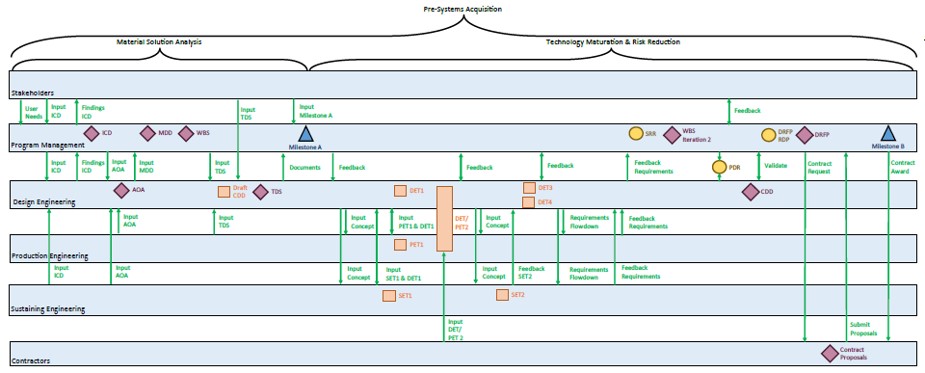
|
|
Assessing the Impact of Development Disruptions & Dependencies in Analysis of Alternatives of System-of-Systems
Co-investigator: Dr. Karen Marais (AAE)
Sponsor:System Engineering Research Center (SERC), DoD UARC
Synopsis: The objective is to develop and test methods that quantify the impact of system interdependencies and other architecture features in the context of SoS capability development. A variety of methods are investigated towards the goal of navigating the decision space that simultaneously considers the potential positive impacts of interdependencies (e.g., SoS capability) and negative impacts (e.g. risk-likelihood and consequences of disruption). The tools are constructed within an analytic workbench framework that would support tradeoff analysis on cost, performance and resilience, among other metrics, while considering the effect of interdependencies.
For more information, please visit the project overview on the SERC website and the project video.
|
|
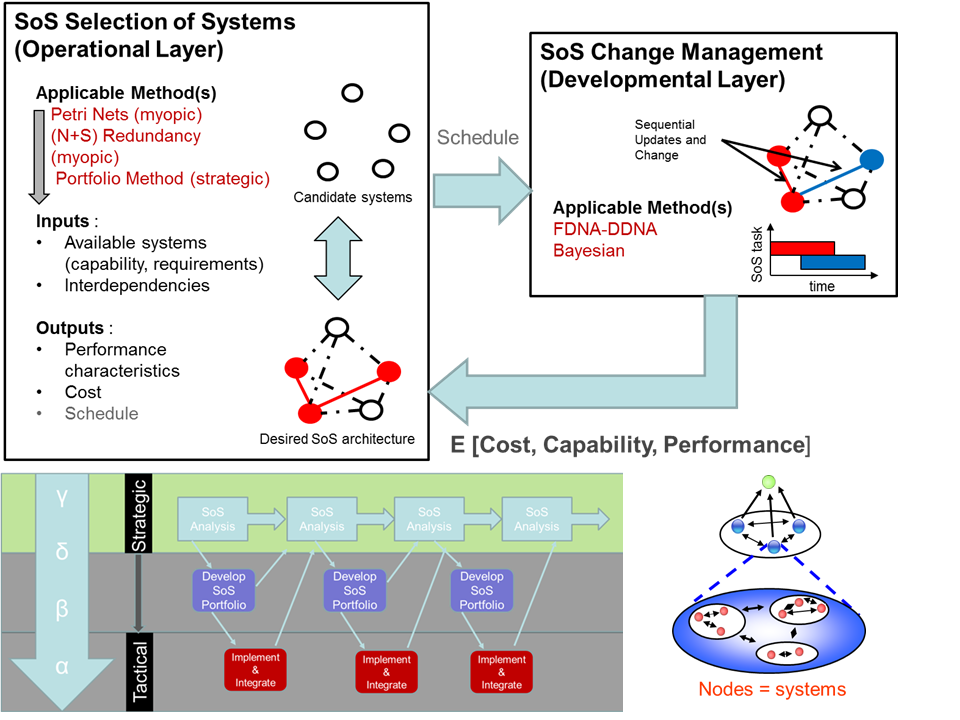
|
|
Simulation based optimization (Hybrid-Sim)
Sponsor: Sandia National Labs
Synopsis:The objective of this project is to develop prototype SoS optimization models to illustrate trade-offs between cost and performance for the proposed simulation-based optimization techniques. First, the SoS models are built in DAF, and then simulation-based optimization techniques are utilized to optimize SoS performance. Expected outputs of this project include procedure to optimize SoS using progressive hedging and an ensemble of surrogates.
|
|
|
|
System-of-Systems Analytic Workbench (SoS-AWB)
Sponsor: Systems Engineering Research Center (SERC), DoD UARC
Synopsis: The objective is to develop organized set of methods, processes and tools (MPTs) to support activities related to SoS architectural evolutions. The SoS-AWB needs to implement methods to make accessible to SoS analysis via online Nanohub implementation. The input data specs is to be developed and needs to evolve MPTs in accordance with collaborator needs is to be investigated.
|
|

|
|
|
Defense Systems
|
|
Investigating Approaches to Achieve Modularity Benefits in the Acquisition Ecosystem
Sponsor: Systems Engineering Research Center (SERC), DoD UARC
Synopsis: The objective is to develop methods, processes and tools (MPTs) to support activities related to SoS architectural evolutions. A concept of MOSA ecosystem is defined to determine utility and to explore different relationships, constructs, factors, metrics, etc. that support quantitative assessment on benefits of modularity. The ecosystem should further explore design patterns and characteristics that enable modularity.
|
|
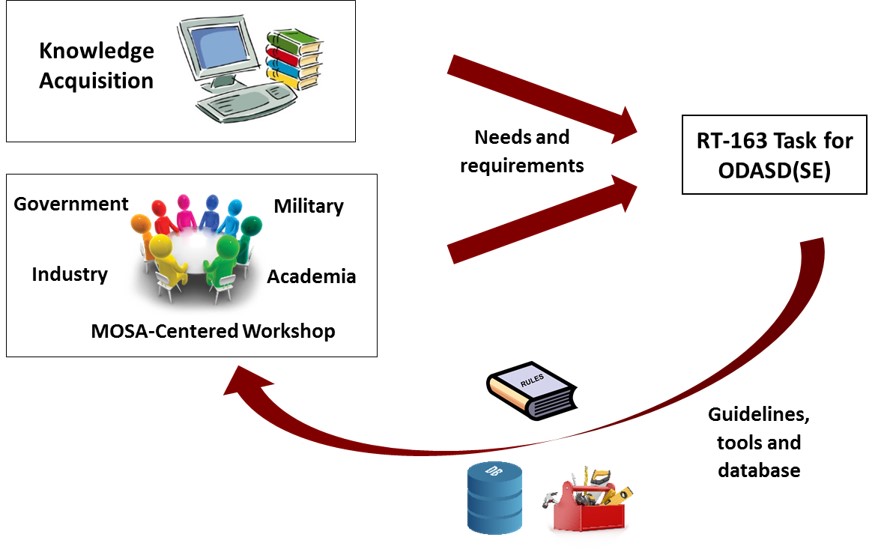
|
|
Lockheed Martin Company (LMC) Integrated Air and Missile Defense Modeling Collaboration
Sponsor: Lockheed Martin
Synopsis: The objective is to develop a flexible, scalable model to optimize IAMD architectures. IAMDs are integration of all sensors and weapons with a missile command in a missile theater. We also aim to identify optimal configuration of COTS/near-COTS systems for a representative, medium-range IAMD scenario. This is achieved by creating medium-fidelity models for constituent systems in DAF and characterizing the design and performance space, and developing metrics to identify the high-performing architectures.
|
|
Research on Defense Acquisition Management for System-of-Systems
Sponsor: Naval Postgraduate School
Synopsis: The objective is to establish an understanding and classification of underlying complexities in the acquisition of system-of-systems. This includes establishing a computer model (exploratory ABM) that exposes the dimensions of connectivity between systems and the impact of system heterogeneity and externalities across the acquisition life-cycle.
|
|
|
|
Sufficient Statistics for System of Systems Control (S4C)
Sponsor: Missile Defense Agency (MDA)
Synopsis: The objective of this project is to build SoS so that it is "correct by design." In this project, we model the control system for missile guidance using DAF, and then conduct the verification and validation using Gaussian processes. Particularly, we model the communication latency between interceptors as well as asymmetry of communication. Outputs of this project include development and implementation of sufficient statistics and associated controllers / estimators for linear systems. In addition, we will create DAF model of cooperative guidance of two missile systems.
|
|
|
|
System of Systems Modeling and Analysis Innovation for Enhanced BMDS Architectures
Co-investigators: Dr. Saurabh Bagchi, ECE
Sponsor: Missile Defense Agency (MDA)
Synopsis: The MDA's mission is to "develop and field an integrated Ballistic Missile Defense System (BMDS) capable of providing a layered defense for the homeland, deployed forces, friends, and allies against ballistic missiles of all ranges in all phases of flight." The present research contract is aimed at achieving a significant improvement in the performance of the Command and Control, Battle Management and Communications (C2BMC) element within the BMDS via disruptive technologies and/or concepts. At maturity, this project will use agent-based models to show the capability of the BMDS to handle large raid sizes with minimal leakage and cost using fixed or adaptive C2BMC architectures.
The following link provides additional information on the project: Press Release
|
|
|
|
Air Force Supply Network and Analysis and Optimization
Synopsis: The Center for Security Policy review of the MCS states that "if the armed forces are to remain capable of successfully performing the multitude of missions levied upon them by our leaders they must have 'among other things' -a dependable and sufficient airlift capacity." However, the current USAF mobility network is unable keep this capability in light of the increasing airlift demands placed upon it for troop transport. Thus, the objective of this research is to model and simulate a supply chain network that is robust and flexible; with both the resources (aircraft, base locations, infrastructure layouts) and the network in which it will operate must be designed and optimized simultaneously.
|
Miscellaneous Topics
|
|
Epidemiological Studies Employing Network Theory & SoS Framework
Co-investigators: Prof. Larry Glickman & Prof. George Moore, Department of Veterinary Pathobiology
Synopsis: The recent occurrence of bird-flu has caused enough agitation and concern among all the nations and has spurred massive research into not only developing vaccines and medications but also epidemic and pandemic rescue operations. The development of successful counter measures not only needs installation of massive infrastructure and management of the logistics therein but also novel approaches based on sophisticated theories concerning both the spread of a potential epidemic and the associated socio-political and socio-economic implications. With rapid globalization underway, the control of epidemics can be classified into an SoS problem. A pilot study has been initiated in collaboration with the department of Veterinary Pathobiology to map the spread of bird-flu using the theories of social-network analysis to examine a hypothetical scenario of the incidence of bird-flu in the Marion County of Indiana. The results from this pilot study are then sought to form important input to the bigger issue of developing an action plan.
|
|
|
|
|
|
Serious Games
Co-Investigators: Prof. Sean Brophy, ENE & Prof. David Ebert, ECE
Sponsor: Purdue Discovery Learning Center
Synopsis: The objective is to transform AAE Introduction to Aerospace Design, our sophomore design course, into a semester-long, team-based, multi-player online Serious Game. The game centers on a "Corporate Simulation" theme, in which learners must pursue quests to obtain knowledge in the midst of competition and collaboration with others. The research emphasis of the project is on engineering education, how students learn to design collaboratively and in distributed settings. The long-term goal is for the Game to be extensible and scalable: to educational levels (K-12 through senior UG) and domain applications (other engineering design courses, and corporate training).
|
|

|
|
|
|
Design Tools for Virtual Worlds
Primary PI: Dr. Sean Brophy, ENE
Contributors: Dr. Masa Okutsu (AAE) and Dr. Mourad Ouzzani (CS)
Sponsor: National Science Foundation (NSF)
Synopsis: This research is oriented toward exploring technological development of interactive models and simulations that enhance learning in a virtual world (VW) for engineering conceptual design couched in a gaming metaphor. The objective of this research is uncover how recent advances in 3-D VW environments and virtual organizations based on "hub" technologies enable college students' self-regulated, but expert guided, exploration of conceptual design spaces and development of engineering literacy skills.
|
|

|
|
|
|
Embedding CyberSecurity Strategies in Distributed Control
Principal Investigator: Dr. Shaoshuai Mou
Co-Investigators: Dr. Daniel DeLaurentis
Sponsor: Northrop Grumman
Synopsis: The objective is to improve the security of large-scale multi-agent networks against cyber-attacks (deception attacks, byzantine attacks, etc.) by embedding cybersecurity strategies in distributed control. The key focus of the SoSL is to construct cyber-resilient distributed controllers and develop a framework of control theoretic approaches to construct the most resilient network for distributed computing.
|
|
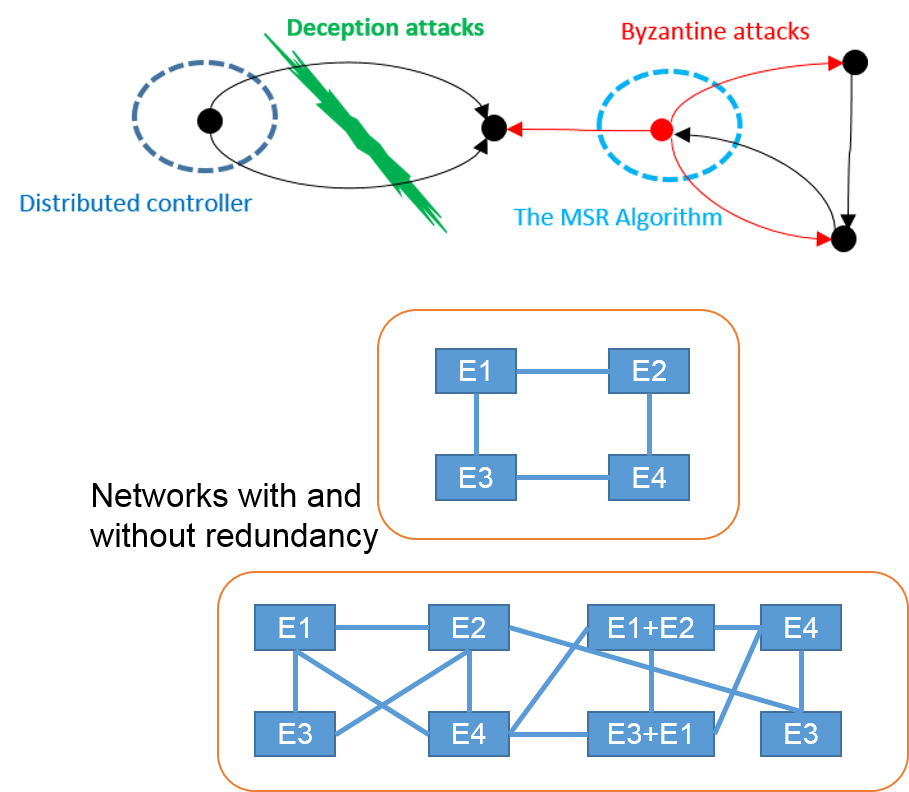
|
|
|
|
Decision-centric foundations to modeling and analysis of complex networked systems
Principal Investigator: Dr. Jitesh Panchal
Co-Investigators: Dr. Daniel DeLaurentis
Sponsor: National Science Foundation (NSF)
Synopsis: The purpose of this project is to establish foundational techniques for modeling and analyzing the evolutionary dynamics of complex endogenous networks in terms of node-level decisions. The central hypothesis is that random-utility discrete-choice theory, based on rational utility-maximizing behavior can be used to effectively model the evolutionary dynamics of complex networked systems.
|
|
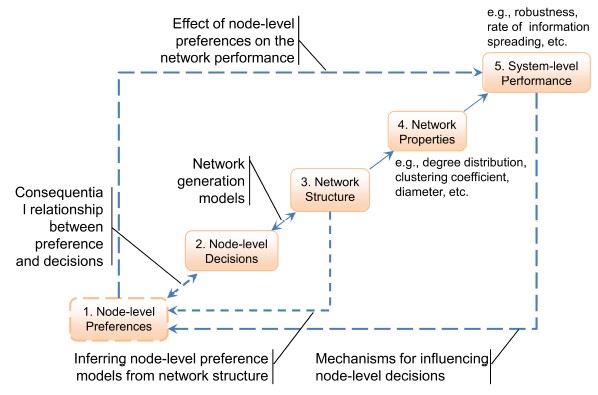
|
|
|
|
Powering What's Next in Freight Transportation
Principal-investigator: Dr. Neera Jain
Co-investigators: Dr. Daniel DeLaurentis, Dr. Greg Shaver
Sponsor: Cummins Inc.
Synopsis:The objective of this project is to imagine the future of freight transportation and identify potential opportunities to power such a future. The project considers intermodal freight transportation and considers the potential for connected and collaborative forms of technologies to be introduced in future transportation concepts. We utilize a system-of-systems driven framework to envision and ultimately identify potentially viable opportunities towards improved outcomes for freight transportation.
|
|
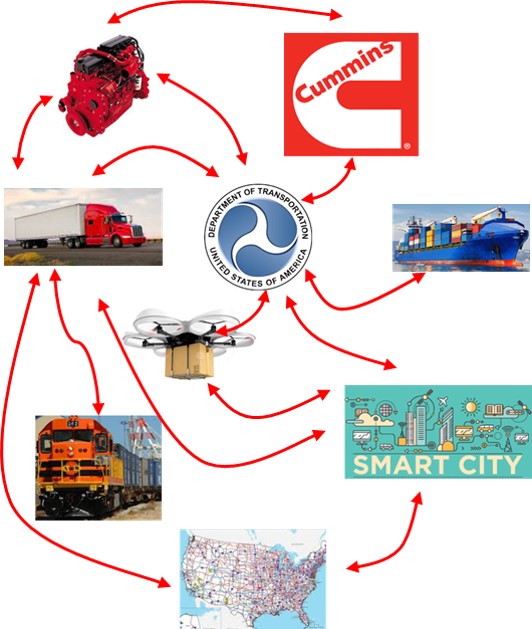
|


























